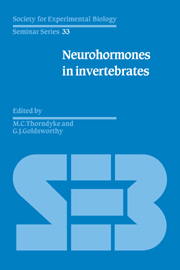Book contents
- Frontmatter
- Contents
- List of contributors
- Preface
- What is special about peptides as neuronal messengers?
- Part I Immunocytochemistry and Ultrastructure
- Part II Arthropod Neurohormones
- Characterization of insect neuropeptides
- The isolation and characterisation of vertebrate-type peptides in insects
- Humoral functions of insect neuropeptides
- Functions of aminergic and peptidergic skeletal motoneurones in insects
- Physiology and biochemistry of crustacean neurohormonal peptides
- Part III Neurohormones in Coelenterates, Annelids and Protochordates
- Part IV Neurohormones in Molluscs
- Index
Characterization of insect neuropeptides
Published online by Cambridge University Press: 04 August 2010
- Frontmatter
- Contents
- List of contributors
- Preface
- What is special about peptides as neuronal messengers?
- Part I Immunocytochemistry and Ultrastructure
- Part II Arthropod Neurohormones
- Characterization of insect neuropeptides
- The isolation and characterisation of vertebrate-type peptides in insects
- Humoral functions of insect neuropeptides
- Functions of aminergic and peptidergic skeletal motoneurones in insects
- Physiology and biochemistry of crustacean neurohormonal peptides
- Part III Neurohormones in Coelenterates, Annelids and Protochordates
- Part IV Neurohormones in Molluscs
- Index
Summary
Introduction
In insects a variety of functions (e.g. intermediary metabolism, ion and osmoregulation, developmental and neuronal processes) are regulated by peptides from different parts of the nervous system. This diversity necessitates the restriction of the present chapter to a particular group of peptides. We have been interested in the structure and biological functions of peptide hormones regulating intermediary metabolism and fluid secretion in insects and these studies are used to highlight the problems encountered in characterizing these peptides.
Lipid and carbohydrate metabolism in insects can be regulated by adipokinetic (AKH) and so-called hyperglycaemic (HGH) hormones present in the corpora cardiaca (Mayer & Candy 1969; Steele 1961). These peptides increase concentrations of haemolymph lipids or carbohydrates. The physiological functions and modes of action of these hormones are reviewed in Chapter 7. Diuretic hormones (DH) present in the corpora cardiaca but also in other parts of the nervous system, e.g. brain, suboesophageal and thoracic ganglia (Proux et al. 1982; Morgan & Mordue 1984a; Aston & Hughes 1980) regulate fluid secretion.
In recent years investigations have been conducted to isolate and characterize prothoracicotropic hormones (PTTH) which stimulate the release of ecdysone from the prothoracic glands (Williams 1947). In Bombyx mori, the PTTHs have been found to exhibit significant homologies in their N-terminal sequences with insulin and insulin-like growth factors (Nagasawa et al. 1984). These peptides are discussed in Chapter 6 which is devoted to the presence of Vertebrate* peptides in insects. The involvement of peptides in the functioning of neurones as neurotransmitters and/or neuromodulators is covered in Chapter 8.
- Type
- Chapter
- Information
- Neurohormones in Invertebrates , pp. 99 - 114Publisher: Cambridge University PressPrint publication year: 1988
- 1
- Cited by



